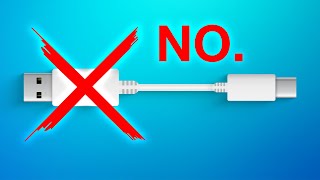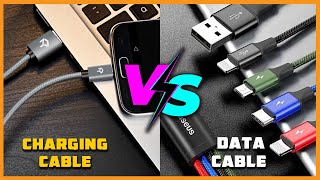You're Probably Using the WRONG USB Charging Cable
 Check out the UGREEN Nexode 140W Charger and Nexode 65W Charging station using the links below! (Sponsored)
Check out the UGREEN Nexode 140W Charger and Nexode 65W Charging station using the links below! (Sponsored)
• UGREEN Nexode 140W Charger(38% OFF, 11.23-11.27): https://bit.ly/49A1CIV
• UGREEN Nexode 65W 7-in-1 Charging Station(47% OFF, 11.23-11.27): https://bit.ly/47l0szw
• UGREEN Black Friday Deals, Up to 50% OFF: https://bit.ly/3sDwKqd
• Buy on UGREEN Official Store, Up to 50% OFF: https://bit.ly/3useel1
▼ Time Stamps: ▼
0:00 – Intro
0:28 – Charging Hardware Factors
1:05 – Types of USB Charging
2:26 – A Good Thing
4:15 – The Actual Charging Ratings
5:32 – Higher Wattage Ratings
7:01 – Are The Wrong Cables Dangerous?
9:21 – Main Points
9:53 – How Do Cables Identify Themselves
10:59 – How Ratings Are Actually Written
13:13 – Other Random Tables
▬▬▬▬▬▬▬▬▬▬▬▬▬▬▬▬▬▬▬▬▬▬▬▬▬▬
• My Gear & Equipment ⇨ https://kit.co/ThioJoe
• Merch ⇨ https://teespring.com/stores/thiojoe
• My Desktop Wallpapers ⇨ https://thiojoe.art/
⇨ http://Instagram.com/ThioJoe
⇨ http://Twitter.com/ThioJoe
⇨ http://Facebook.com/ThioJoeTV
▬▬▬▬▬▬▬▬▬▬▬▬▬▬▬▬▬▬▬▬▬▬▬▬▬▬


As a non-geek I was happily ignorant about cables before watching this video. I was content to match plugs to sockets. Charging speed was not a concern. Now I am still not concerned about charging speed but all that information has me confused. Ug.
I have a USB A to C cable that charges my phone at more than 20 watts ,so 8 think the claim these cables suport up to 15 watts is not true
1:41 Thank you so much for adding the AI prompt used to create the image. Totally would like to see more creators do this.
9:29 baseline
There is no such thing as amperage. The word you are looking for is current. Triggered! 🙂
Thanks for 0:54 Now I’m no longer confused of watts and voltage
Can you link the USB volt meter you are using in the video ?
Ampere is an app that shows details when charging. I run that while testing my different chargers and cables to determine which combination works the best.
My main multiport chargers all have only A sockets. So do my power banks. Hence we do all our charging with A to C cables.
basically , a good 100 or 240w usbc-usbc cables are more expsive and are much thicker..
cheap chinese usbc cables sold for few bucks at gas stations are going to give 60w at best..
I’m annoyed by the prevalence of high power only chargers. I would prefer my battery to last longer, so slower charging is what i prefer. If cables could help me reduce the power going to my portable devices, that would be great!
$89 for a ugreen 140w charger? I’ll wait an extra 25 min for my phone to charge lol
You make a lot of mistakes, here.
For example, manufacturers do make USB A to USB C cables that charge faster than 15 watts.
The specification doesn’t allow for it, but it is done anyway.
4:41 I have several. Having USB C outlets, and still many USB Mini B devices, not Micro, Mini, like older external hard drives, I wanted to plug them in to the USB C ports.
It’s a bit silly that those top 3 lines are rated 3A, because USB 2.0 A should only ever deliver a maximum of 500mA, and the USB 3 port should only deliver a maximum of 1.5A.
Can you make a video on the correlation to the cable watts and what type of charging brick you need ?!?
Genuinely learned something in this video. Have a like! I will peruse your channel.
I might just stick with Thunderbolt 5 cables. Easy way to be sure of what I’m getting.
You forgot one important fact: Because of how the e-markers were designed, usb-c extension cords are actually officially unsupported, but still produced, and my cause a fire hazard.
In simple terms, the device cannot read two e-markers, which if would have to if an extension is used, so it just reads the first one ignoring data or power limits of the second. Kinda stupid right?
lol i run a large format dc compressor fridge with usb-c. i put a video on my channel. basically use a pd 3.1 trigger baord and run the fridge at 28v since most 12v appliances actually work on 24v, and 24v spec includes 28v coz of how car/truck altenators work by putting out around 14.5v per lead acid battery. been running in my living room for a year. my modifications to the fridge and use of a gan pd 3.1 power supply cuts power use by about 70%
I didn’t learn anything from this. This guy just garbled out numbers for 10 minutes then at the end he said something about a water pipe like that’s supposed to help? I thought you were talking about charging phones
4:11 even if i don’t buy Ugreen, the commercial was very informative.
Some USB A to C cables would do 56K pull-up resistors to both CC pins instead of just the one on the side of the data pins which would also not work with some devices. There’s only supposed to be 1 resistor to the CC pin on the side of the data connection
After watching, I am still not an expert. I will buy a china 10a cable because bigger number sounds more impressive.
You said the reason for running high voltage on distribution lines was to lower current. While this is the result of increasing voltage, it is not the actual reason for doing it. Increasing voltage lowers I squared/R losses (current squared divided by resistance) which saves power companies money.
I accidenly wrecked all three different sony phones I had over the years by charging them with chargers from friends. The batteries just wouldn’t charge at all afterwards. I still don’t know what that was about. (And no, I didn’t use the same charger from the same friend all three times)
For "Universal Serial Bus" I haven’t seen any busses at all in this video
Was really hoping to get a ride man
8:29 It kind of reminds me of what a USB killer does
Ok but my phone requires a lightning connector at one end?
Regret: didn’t label. 1:33 never knew it mattered for charging.
8:04 But the old USB-A 2.0 cables and slots won’t have the ability to communicate like that. Power comes from the USB-A end, and if it’s coming from that end, it’s usually just a standard 5V power output. (not sure of the amperage) But I fully don’t believe USB-A has any sort of power delivery or power negotiation circuit as the USB-C’s.
3:59 his voice changed to a voice you would hear in a commercial kinda in this part lol
Yes those old cables CAN charge things. It is just the RATE of the charge.
Actually a slow charge is best to charge any battery (less heat).
@9:48, if the minimum is 60W for type c to c cable. then why samsung s24 ultra default charging cable in the box is only up to 25W. 🫠
well I have usb a to usb c cable that is supports 120w charging from factory in Mi phone it come with phone
I knew it. It wasn’t just my imagination. (I need to get me one of those cable testers. Where can I get one?)
For the resistor in the USB-A portion.. I have a back massager (of all things) that essentially requires that pre-communication and I didn’t know what was triggering it.. lol however it can detect it not having the proper cord and it won’t let you charge and won’t turn on the charging light.. some devices have at the very least protection enough to be a detector in that case..
I would never have needed to know this information if someone wasn’t texting and driving.. My back wouldn’t hurt lol….
I was wondering why new Samsung Galaxy S24 chargers were USB C to USB C. Thanks!
Being in the Certification field previously, up to 100W is a very good upper limit. That’s the border between Class 2 and Class 3. Class 3 is the same category of mains powered equipment, Class 1 is up to 15W and Class 2 is between 15W and 100W. The amount of extra safety tests something has to pass if it goes above 100W is crazy.
Basically, anything that above 100W has to be able to handle mains power going through it to pass the test, which is why you don’t even have 180W cables, Might as well just go for 240W cables because it’s easier to pass the safety tests.
Why the 5A limit? that’s another limiting specification in the safety standards.
Please just tell me what type of charger is the best and fastest
for an android phone.
I have a USB A to C made by Xiaomi that delivers 120w 🤔 and yes that’s my standard charger
To fast to comprihent.
I say, deliver me from power delivery via data transfer terminals. I defy anything beyond 0.5 A in my USB port. You need more than that – you need a proper, separate power socket and a proper, 2-wire power cable of appropriate cross-section. Enough of that madness "lets shove power line directly into CPU and see what happens".
This video is wrong on the USB-A to C information. There are USB A to C cables that can deliver more then 15W, but those are more like custom cables.
The USB cable that comes with a smartphone for example. I have a phone that charges with 67W and it came with an USB-A charger and an USB-A to C cable. It charges with 67W with that included charger and cable. That USB-A charger uses either 5V/3A or fast charge with 20V/3,25A.
There are lots of Xiaomi Type C to A cables out there that support up to 120W power. How do you explain that as that doesn’t fit in your explanation in this video.
What abount if my charger is uses USB 2.0?
me watching a 1 year old thiojoe vid at 1am
So many tech explanation….. 🥴🥴🥴🥴🥴
I’ve been using my current phone for 3 years now and it survived countless falls unscathed, even from the top of my truck going 50mph (it’s got a good case). It fully charges in less than half an hour regardless of which cord I use (has to be the original charger that came with the phone) and has no difficulty going for the whole day. The cord, on the other hand, breaks one after another. It just seems more logical to invest in quantity over quality at this point. I have huge respect for people who can have so many old cords lying around. Mine almost never survive to old age. 😂
You can’t increase the voltage. Hardware is designed for a very specific voltage rating, and if it exceeds that voltage rating it *_will_* destroy the device. You can only safely increase _amperage_ above what is recommended. It is just the nature of how electronics work that they only draw as many amps as is necessary. All USB cables are rated for 5v. Never buy a USB charger that is not 5v unless you absolutely know what you’re doing. It is safe to buy USB charger that has as high amperage as you desire, however.
What happen if i use a C -> A -> C cable, it supports Power delivery or its explode? (C -> A, convert to C)